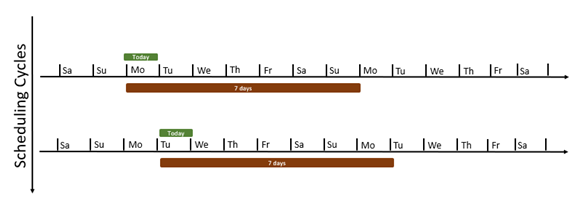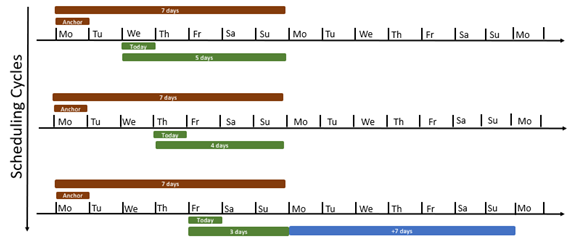Schedule Parameters
Schedule parameters mark key horizon settings and determine scheduling behavior.
Configure Schedule Parameters
-
Specify the fixed time fence duration. Start dates of firm work orders defined in Oracle Fusion Cloud Manufacturing, and that fall within this horizon, will be respected.
-
Specify the horizon extension type to control how the application determines the horizon start and the fixed time fence.
-
If you select Rolling, the duration of the fixed time fence stays constant while the start date shifts by a day, each day.
-
If the anchor time is midnight, and the schedule refresh is performed after midnight on the same day, the fixed time fence will be counted from midnight on that day, regardless of what time the schedule refresh is performed.


-
If the anchor time isn't midnight, let's say it's 8:00 a.m. today, and a schedule refresh is done after 8:00 a.m. today, then the horizon start and fixed time fence start is 8:00 a.m. today. But if a refresh is performed before 8:00 a.m. on a given day, the horizon start time fence start will be 8:00 a.m. the previous day.


-
-
If you select Dynamic, the horizon start is the current day, and the time fence shrinks with each passing day until it reaches a time fence minimum duration. When this minimum value is reached, the time fence gets extended. If you select this extension type, you must also specify the time fence minimum duration and time fence extension duration.
-
The time fence shrinkage is the difference between the fixed time fence duration and the number of days between the current day and the last day of the time fence. So if the anchor date and time is Monday 12:00 a.m., the fixed time fence duration is 7 days, and you're refreshing the schedule at Thursday 12:00 a.m., the time fence has shrunk to 4 days. If you set the minimum as 4 days and the extension as 7 days, then from Friday 12:00 a.m., the time fence will have shrunk to 3 days, which is below the limit of 4 days, and will extend by the extension duration of 7 days. This results in a total time fence duration of 10 days.


Tip: The dynamic mode works best if the fixed time fence duration is a multiple of 7. -
-
-
Specify the resource constraint horizon, a duration that's counted from the horizon start date. Resource capacity constraints and calendar events within this horizon are respected during scheduling.
-
Select the anchor date and time, which is used to calculate the fixed time fence start, the schedule horizon start, and, if scheduling buckets are used, the scheduling bucket start date and time. The schedule horizon start and fixed time fence start will be the last time value of the anchor date and time before a schedule refresh; the scheduling bucket start will be the anchor date and time.
-
Specify the release horizon, a duration that's counted from the horizon start. Work orders with start dates within this horizon only will be released.
- Specify the lateness tolerance in hours. Lateness tolerance is the number of hours from a Need By date by which a demand or work order is considered late by the application.
-
Specify whether to firm released work orders that begin during the fixed time fence period.
- If the Firm released work orders that begin during the fixed time fence period check box is enabled, then during the schedule refresh all the released work orders within the fixed time fence are firmed.
- When repair, solve or schedule release is run, the firm status of the other work orders remains unchanged. You can change the firm status of the work orders only through the Work Orders table.
-
Specify the work order release status settings when the schedule is published.
- If you select Mark work orders as released, the work orders irrespective of their current status will be set to Released when the schedule is published.
- If you select Retain current work order status, the work orders retain their current status when the schedule is published.